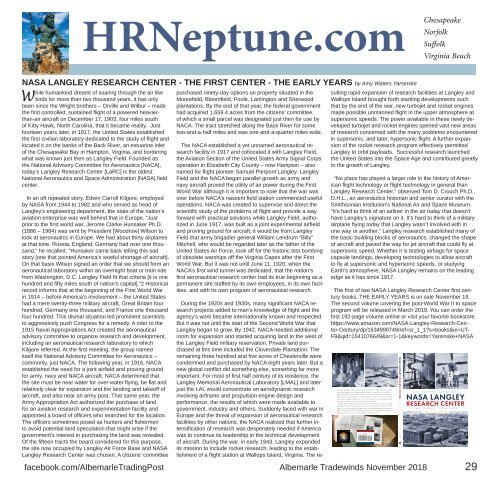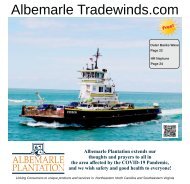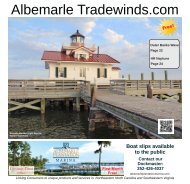Tradewinds November 2018 Web Opt
Albemarle Tradewinds November 2018 is now online. Look for the printed edition later in the week at your favorite location
Albemarle Tradewinds November 2018 is now online. Look for the printed edition later in the week at your favorite location
You also want an ePaper? Increase the reach of your titles
YUMPU automatically turns print PDFs into web optimized ePapers that Google loves.
$28.99<br />
ISBN 978-1-63499-074-5<br />
5 2 8 9 9<br />
9 7 8 1 6 3 4 9 9 0 7 4 5<br />
America Through Time® and Adding Color to American History are registered and/or unregistered trademarks.<br />
HRNeptune.com<br />
<br />
<br />
<br />
<br />
NASA LANGLEY RESEARCH CENTER - THE FIRST CENTER - THE EARLY YEARS by Amy Waters Yarsinske<br />
While humankind dreamt of soaring through the air like<br />
birds for more than two thousand years, it has only<br />
been since the Wright brothers – Orville and Wilbur – made<br />
the first controlled, sustained flight of a powered heavierthan-air<br />
aircraft on December 17, 1903, four miles south<br />
of Kitty Hawk, North Carolina, that it became reality. Just<br />
fourteen years later, in 1917, the United States established<br />
the first civilian laboratory dedicated to the study of flight and<br />
located it on the banks of the Back River, an estuarine inlet<br />
of the Chesapeake Bay in Hampton, Virginia, and bordering<br />
what was known just then as Langley Field. Founded as<br />
the National Advisory Committee for Aeronautics [NACA],<br />
today’s Langley Research Center [LaRC] is the oldest<br />
National Aeronautics and Space Administration [NASA] field<br />
center.<br />
In an oft repeated story, Edwin Carroll Kilgore, employed<br />
by NASA from 1944 to 1982 and who served as head of<br />
Langley’s engineering department, the state of the nation’s<br />
aviation enterprise was well behind that in Europe. “Just<br />
prior to the first world war, Jerome Clarke Hunsaker Ph.D.<br />
(1886 – 1984) was sent by President [Woodrow] Wilson to<br />
look at aeronautics in Europe. We had about thirty airplanes<br />
at that time. Russia, England, Germany had over one thousand,”<br />
he recalled. “Hunsaker came back telling this sad<br />
story [one that pointed America’s woeful shortage of aircraft].<br />
On that basis Wilson signed an order that we should form an<br />
aeronautical laboratory within an overnight boat or train ride<br />
from Washington, D.C. Langley Field fit that criteria [it is one<br />
hundred and fifty miles south of nation’s capital].”2 Historical<br />
record informs that at the beginning of the First World War<br />
in 1914 – before America’s involvement – the United States<br />
had a mere twenty-three military aircraft, Great Britain four<br />
hundred, Germany one thousand, and France one thousand<br />
four hundred. This dismal situation led prominent scientists<br />
to aggressively push Congress for a remedy. A rider to the<br />
1915 Naval Appropriations Act created the aeronautical<br />
advisory committee to organize research and development,<br />
including an aeronautical research laboratory to which<br />
Kilgore referred. At the first meeting, the group named<br />
itself the National Advisory Committee for Aeronautics –<br />
commonly, just NACA. The following year, in 1916, NACA<br />
established the need for a joint airfield and proving ground<br />
for army, navy and NACA aircraft. NACA determined that<br />
the site must be near water for over-water flying, be flat and<br />
relatively clear for expansion and the landing and takeoff of<br />
aircraft, and also near an army post. That same year, the<br />
Army Appropriation Act authorized the purchase of land<br />
for an aviation research and experimentation facility and<br />
appointed a board of officers who searched for the location.<br />
The officers sometimes posed as hunters and fishermen<br />
to avoid potential land speculation that might arise if the<br />
government’s interest in purchasing the land was revealed.<br />
Of the fifteen tracts the board considered for this purpose,<br />
the site now occupied by Langley Air Force Base and NASA<br />
Langley Research Center was chosen. A citizens’ committee<br />
purchased ninety-day options on property situated in the<br />
Moorefield, Bloomfield, Poole, Lamington and Sherwood<br />
plantations. By the end of that year, the federal government<br />
had acquired 1,659.4 acres from the citizens’ committee,<br />
of which a small parcel was designated just then for use by<br />
NACA. The tract stretched along the Back River for some<br />
two-and-a-half miles and was one-and-a-quarter miles wide.<br />
The NACA established a yet unnamed aeronautical research<br />
facility in 1917 and collocated it with Langley Field,<br />
the Aviation Section of the United States Army Signal Corps<br />
operation in Elizabeth City County – now Hampton – also<br />
named for flight pioneer Samuel Pierpont Langley. Langley<br />
Field and the NACA began parallel growth as army and<br />
navy aircraft proved the utility of air power during the First<br />
World War although it is important to note that the war was<br />
over before NACA’s nascent field station commenced useful<br />
operations. NACA was created to supervise and direct the<br />
scientific study of the problems of flight and provide a way<br />
forward with practical solutions while Langley Field, authorized<br />
in June 1917, was built as a joint experimental airfield<br />
and proving ground for aircraft; it would be from Langley<br />
Field that army brigadier general William Lendrum “Billy”<br />
Mitchell, who would be regarded later as the father of the<br />
United States Air Force, took off for the historic test bombing<br />
of obsolete warships off the Virginia Capes after the First<br />
World War. But it was not until June 11, 1920, when the<br />
NACA’s first wind tunnel was dedicated, that the nation’s<br />
first aeronautical research center had its true beginning as a<br />
permanent site staffed by its own employees, in its own facilities,<br />
and with its own program of aeronautical research.<br />
During the 1920s and 1930s, many significant NACA research<br />
projects added to man’s knowledge of flight and the<br />
agency’s work became internationally known and respected.<br />
But it was not until the start of the Second World War that<br />
Langley began to grow. By 1942, NACA needed additional<br />
room for expansion and started acquiring land to the west of<br />
the Langley Field military reservation. Private land purchased<br />
at this time included the Cloverdale Plantation. The<br />
remaining three hundred and five acres of Chesterville were<br />
condemned and purchased by NACA eight years later. But a<br />
new global conflict did something else, something far more<br />
important. For most of first half century of its existence, the<br />
Langley Memorial Aeronautical Laboratory [LMAL] and later<br />
just the LAL would concentrate on aerodynamic research<br />
involving airframe and propulsion engine design and<br />
performance, the results of which were made available to<br />
government, industry and others. Suddenly faced with war in<br />
Europe and the threat of expansion of aeronautical research<br />
facilities by other nations, the NACA realized that further intensification<br />
of research was desperately needed if America<br />
was to continue its leadership in the technical development<br />
of aircraft. During the war, in early 1943, Langley expanded<br />
its mission to include rocket research, leading to the establishment<br />
of a flight station at Wallops Island, Virginia. The resulting<br />
rapid expansion of research facilities at Langley and<br />
Wallops Island brought forth startling developments such<br />
that by the end of the war, new turbojet and rocket engines<br />
made possible unmanned flight in the upper atmosphere at<br />
supersonic speeds. The power available in these newly developed<br />
turbojet and rocket engines opened vast new areas<br />
of research concerned with the many problems encountered<br />
in supersonic, and later, hypersonic flight. A further expansion<br />
of the rocket research program effectively permitted<br />
Langley to orbit payloads. Successful research launched<br />
the United States into the Space Age and contributed greatly<br />
to the growth of Langley.<br />
“No place has played a larger role in the history of American<br />
flight technology or flight technology in general than<br />
Langley Research Center,” observed Tom D. Crouch Ph.D.,<br />
D.H.L., an aeronautics historian and senior curator with the<br />
Smithsonian Institution’s National Air and Space Museum.<br />
“It’s hard to think of an airliner in the air today that doesn’t<br />
have Langley’s signature on it. It’s hard to think of a military<br />
airplane flying today that Langley wasn’t involved with in<br />
one way or another.” Langley research established many of<br />
the basic building blocks of aeronautics, changed the shape<br />
of aircraft and paved the way for jet aircraft that could fly at<br />
supersonic speed. Whether it is testing airbags for space<br />
capsule landings, developing technologies to allow aircraft<br />
to fly at supersonic and hypersonic speeds, or studying<br />
Earth’s atmosphere, NASA Langley remains on the leading<br />
edge as it has since 1917.<br />
The first of two NASA Langley Research Center first century<br />
books, THE EARLY YEARS is on sale <strong>November</strong> 19.<br />
The second volume covering the post-World War II to space<br />
program will be released in March 2019. You can order the<br />
first 192-page volume online or visit your favorite bookstore.<br />
https://www.amazon.com/NASA-Langley-Research-Cen-<br />
ter-Century/dp/1634990749/ref=sr_1_1?s=books&ie=UT-<br />
F8&qid=1541076649&sr=1-1&keywords=Yarsinske+NASA<br />
“No place has played a larger role in the history of American flight technology or flight<br />
technology in general than Langley Research Center,” observed Tom D. Crouch Ph.D.,<br />
D.H.L., an aeronautics historian and senior curator with the Smithsonian Institution’s<br />
National Air and Space Museum. “It’s hard to think of an airliner in the air today that<br />
doesn’t have Langley’s signature on it. It’s hard to think of a military airplane flying<br />
today that Langley wasn’t involved with in one way or another.”<br />
Langley research established many of the basic building blocks of aeronautics, changed<br />
the shape of aircraft and paved the way for jet aircraft that could fly at supersonic speed.<br />
Whether it is testing airbags for space capsule landings, developing technologies to<br />
allow aircraft to fly at supersonic and hypersonic speeds, or studying Earth’s atmosphere,<br />
NASA Langley remains on the leading edge as it has since 1917.<br />
facebook.com/AlbemarleTradingPost Albemarle <strong>Tradewinds</strong> <strong>November</strong> <strong>2018</strong> 29<br />
America Through Time®<br />
www.through-time.com<br />
Connect with us:<br />
fAmericaThroughTime<br />
t@USAThroughTime<br />
I AmericaThroughTime<br />
NASA LANGLEY RESEARCH CENTER<br />
THE EARLY YEARS AMY WATERS YARSINSKE<br />
AMY WATERS YARSINSKE<br />
NASA LANGLEY<br />
RESEARCH CENTER<br />
THE FIRST CENTURY<br />
THE EARLY YEARS

















